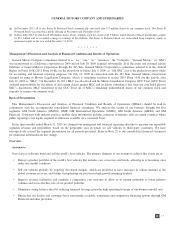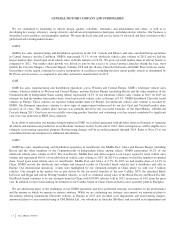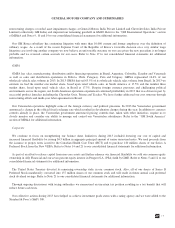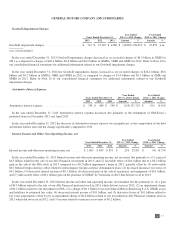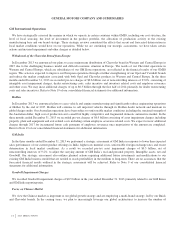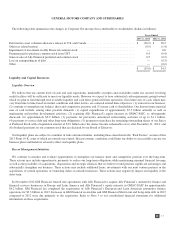General Motors 2013 Annual Report Download - page 27
Download and view the complete annual report
Please find page 27 of the 2013 General Motors annual report below. You can navigate through the pages in the report by either clicking on the pages listed below, or by using the keyword search tool below to find specific information within the annual report.
GENERAL MOTORS COMPANY AND SUBSIDIARIES
Reconciliation of Consolidated, Automotive and GM Financial Segment Results
Non-GAAP Measures
Management believes earnings before interest and tax (EBIT)-adjusted provides meaningful supplemental information regarding
our automotive segments’ operating results because it excludes interest income, interest expense and income taxes as well as certain
additional adjustments. Such adjustments include impairment charges related to goodwill, other long-lived assets under certain
circumstances and certain investments, gains or losses on the settlement/extinguishment of obligations and gains or losses on the sale
of non-core investments.
Management believes free cash flow and adjusted free cash flow provide meaningful supplemental information regarding the
liquidity of our automotive operations and our ability to generate sufficient cash flow above those required in our business to sustain
our operations. We measure free cash flow as cash flow from operations less capital expenditures. We measure adjusted free cash
flow as free cash flow adjusted for management actions, primarily related to strengthening our balance sheet, such as accrued interest
on prepayments of debt and voluntary contributions to employee benefit plans.
Management believes these measures allow it to readily view operating trends, perform analytical comparisons and benchmark
performance between periods and among geographic regions. We believe these non-GAAP measures are useful in allowing for greater
transparency of our core operations and are therefore used by management in its financial and operational decision-making.
Management does not consider the excluded items when assessing and measuring the operational and financial performance of the
organization, its management teams and when making decisions to allocate resources, such as capital investment, among business
units and for internal reporting and as part of its forecasting and budgeting processes.
While management believes that these non-GAAP measures provide useful information, they are not operating measures under U.S.
GAAP and there are limitations associated with their use. Our calculation of these non-GAAP measures may not be comparable to
similarly titled measures of other companies due to potential differences between companies in the method of calculation. As a result
the use of these non-GAAP measures has limitations and should not be considered in isolation from, or as a substitute for, other
measures such as Net income, Net income attributable to stockholders or operating cash flow. Due to these limitations, these non-
GAAP measures are used as supplements to U.S. GAAP measures.
Management believes income before income taxes provides meaningful supplemental information regarding GM Financial’s
operating results. GM Financial uses a separate measure from our automotive operations because management believes interest
income and interest expense are part of operating results when assessing and measuring the operational and financial performance of
the segment.
25




